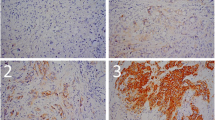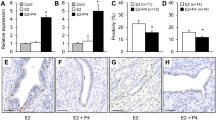Abstract
Purpose To measure peptide concentrations and mRNA expression of the IGF Family in breast cancer and to examine their associations with the disease features. Experimental design Fresh tumor samples were collected from 348 patients who underwent surgery for breast cancer. Tissue levels of mRNA and peptide of IGF-I, IGF-II, and IGFBP-3 were analyzed with real-time RT-PCR and ELISA, respectively. Cox proportional hazards regression model was used to examine the associations of IGF markers with patient survival. Results Age was inversely associated with IGF-I, IGF-II and IGFBP-3 at both mRNA and peptide levels. Small tumors, early TNM stages, or low grades were associated with high mRNA expression of IGFs and IGFBP-3. Hormone receptors were positively correlated with IGF-I and IGF-II expression. Survival analysis showed that patients with high expression of one of the IGF-I transcripts, IGF-IA, had lower risk of disease recurrence (HR = 0.47, 95%CI: 0.27–0.81) and death (HR = 0.35, 95%CI: 0.18–0.70) compared to those with low expression. High IGFBP-3 expression was also inversely associated with reduced risk of death (HR = 0.47, 95%CI: 0.23–0.95). Similar associations, however, were not observed when tissue levels of IGF-I peptide or IGFBP-3 protein were analyzed. High IGF-II peptide was related to increased risk of relapse (HR = 1.91, 95%CI: 1.12–3.27). Conclusion Our findings of high mRNA expression of IGFs and IGFBP-3 being associated with less aggressive tumors and favorable prognosis were consistent with previous observations, but were not supported by the measurement of tissue levels of IGF-I peptide and IGFBP-3 protein, suggesting that IGF mRNA expression and tissue levels of IGF peptides are regulated by different mechanisms and assessing these molecules in tumor tissue may have different implications.


Similar content being viewed by others
References
Yu H, Rohan T (2000) Role of the insulin-like growth factor family in cancer development and progression. J Natl Cancer Inst 92:1472–1489
Yee D (2007) Targeting insulin-like growth factor pathways. Br J Cancer 96:R7–R10
Renehan AG, Harvie M, Howell A (2006) Insulin-like growth factor (IGF)-I, IGF binding protein-3, and breast cancer risk: eight years on. Endocr Relat Cancer 13:273–278
Pollak M (2007) Insulin-like growth factor-related signaling and cancer development. Recent Results Cancer Res 174:49–53
Lee AV, Yee D (1995) Insulin-like growth factors and breast cancer. Biomed Pharmacother 49:415–421
Pratt SE, Pollak MN (1993) Estrogen and antiestrogen modulation of MCF7 human breast cancer cell proliferation is associated with specific alterations in accumulation of insulin-like growth factor-binding proteins in conditioned media. Cancer Res 53:5193–5198
Yee D, Jackson JG, Kozelsky TW, Figueroa JA (1994) Insulin-like growth factor binding protein 1 expression inhibits insulin-like growth factor I action in MCF-7 breast cancer cells. Cell Growth Differ 5:73–77
Langeland Marthinsen AB, Dybdahl Wanderas A, Lundgren S, Strickert T, Hundal E, Graff BA (2002) Effects of growth factors on growth and radiation sensitivity of the human breast cancer cell line T-47D. Oncol Rep 9:397–403
Dhar K, Banerjee S, Dhar G, Sengupta K, Banerjee SK (2007) Insulin-like growth factor-1 (IGF-1) induces WISP-2/CCN5 via multiple molecular cross-talks and is essential for mitogenic switch by IGF-1 axis in estrogen receptor-positive breast tumor cells. Cancer Res 67:1520–1526
Borowiec AS, Hague F, Harir N, Guenin S, Guerineau F, Gouilleux F, Roudbaraki M, Lassoued K, Ouadid-Ahidouch H (2007) IGF-1 activates hEAG K(+) channels through an Akt-dependent signaling pathway in breast cancer cells: role in cell proliferation. J Cell Physiol 212:690–701
Burger AM, Leyland-Jones B, Banerjee K, Spyropoulos DD, Seth AK (2005) Essential roles of IGFBP-3 and IGFBP-rP1 in breast cancer. Eur J Cancer 41:1515–1527
Clemmons DR (1997) Insulin-like growth factor binding proteins and their role in controlling IGF actions. Cytokine Growth Factor Rev 8:45–62
Kelley KM, Oh Y, Gargosky SE, Gucev Z, Matsumoto T, Hwa V, Ng L, Simpson DM, Rosenfeld RG (1996) Insulin-like growth factor-binding proteins (IGFBPs) and their regulatory dynamics. Int J Biochem Cell Biol 28:619–637
Nickerson T, Huynh H, Pollak M (1997) Insulin-like growth factor binding protein-3 induces apoptosis in MCF7 breast cancer cells. Biochem Biophys Res Commun 237:690–693
Perks CM, Holly JM (2000) Insulin-like growth factor binding proteins (IGFBPs) in breast cancer. J Mammary Gland Biol Neoplasia 5:75–84
Goodwin PJ, Ennis M, Pritchard KI, Trudeau ME, Koo J, Hartwick W, Hoffma B, Hood N (2002) Insulin-like growth factor binding proteins 1 and 3 and breast cancer outcomes. Breast Cancer Res Treat 74:65–76
Vadgama JV, Wu Y, Datta G, Khan H, Chillar R (1999) Plasma insulin-like growth factor-I and serum IGF-binding protein 3 can be associated with the progression of breast cancer, and predict the risk of recurrence and the probability of survival in African-American and Hispanic women. Oncology 57:330–340
Holdaway IM, Mason BH, Lethaby AE, Singh V, Harvey VJ, Thompson PI, Evans BD (2003) Serum insulin-like growth factor-I and insulin-like growth factor binding protein-3 following chemotherapy for advanced breast cancer. ANZ J Surg 73:905–908
Perks C, Holly J (2003) Actions of IGFBP on epithelial cancer cells: potential for new therapeutic targets. Horm Metab Res 35:828–835
Eppler E, Zapf J, Bailer N, Falkmer UG, Falkmer S, Reinecke M (2002) IGF-I in human breast cancer: low differentiation stage is associated with decreased IGF-I content. Eur J Endocrinol 146:813–821
Ren Z, Shin A, Cai Q, Shu XO, Gao YT, Zheng W (2007) IGFBP3 mRNA expression in benign and malignant breast tumors. Breast Cancer Res 9:R2
Rocha RL, Hilsenbeck SG, Jackson JG, Lee AV, Figueroa JA, Yee D (1996) Correlation of insulin-like growth factor-binding protein-3 messenger RNA with protein expression in primary breast cancer tissues: detection of higher levels in tumors with poor prognostic features. J Natl Cancer Inst 88:601–606
Rocha RL, Hilsenbeck SG, Jackson JG, VanDenBerg CL, Weng C, Lee AV, Yee D (1997) Insulin-like growth factor binding protein-3 and insulin receptor substrate-1 in breast cancer: correlation with clinical parameters and disease-free survival. Clin Cancer Res 3:103–109
Shin A, Ren Z, Shu XO, Cai Q, Gao YT, Zheng W (2007) Expression patterns of insulin-like growth factor 1 (IGF-I) and its receptor in mammary tissues and their associations with breast cancer survival. Breast Cancer Res Treat 105:55–61
Toropainen E, Lipponen P, Syrjanen K (1995) Expression of insulin-like growth factor I (IGF-I) in female breast cancer as related to established prognostic factors and long-term prognosis. Eur J Cancer 31A:1443–1448
Vestey SB, Perks CM, Sen C, Calder CJ, Holly JM, Winters ZE (2005) Immunohistochemical expression of insulin-like growth factor binding protein-3 in invasive breast cancers and ductal carcinoma in situ: implications for clinicopathology and patient outcome. Breast Cancer Res 7:R119–R129
Yee D, Sharma J, Hilsenbeck SG (1994) Prognostic significance of insulin-like growth factor-binding protein expression in axillary lymph node-negative breast cancer. J Natl Cancer Inst 86:1785–1789
Yu H, Levesque MA, Khosravi MJ, Papanastasiou-Diamandi A, Clark GM, Diamandis EP (1998) Insulin-like growth factor-binding protein-3 and breast cancer survival. Int J Cancer 79:624–628
Haffner MC, Petridou B, Peyrat JP, Revillion F, Muller-Holzner E, Daxenbichler G, Marth C, Doppler W (2007) Favorable prognostic value of SOCS2 and IGF-I in breast cancer. BMC Cancer 7:136
Manni A, Wei L, Badger B, Zaenglein A, Leighton J, Shimasaki S, Ling N (1992) Expression of messenger RNA for insulin-like growth factors and insulin-like growth factor binding proteins by experimental breast cancer and normal breast tissue in vivo. Endocrinology 130:1744–1746
Mizukami Y, Nonomura A, Yamada T, Kurumaya H, Hayashi M, Koyasaki N, Taniya T, Noguchi M, Nakamura S, Matsubara F (1990) Immunohistochemical demonstration of growth factors, TGF-alpha, TGF-beta, IGF-I and neu oncogene product in benign and malignant human breast tissues. Anticancer Res 10:1115–1126
Chong YM, Williams SL, Elkak A, Sharma AK, Mokbel K (2006) Insulin-like growth factor 1 (IGF-1) and its receptor mRNA levels in breast cancer and adjacent non-neoplastic tissue. Anticancer Res 26:167–173
Nardon E, Buda I, Stanta G, Buratti E, Fonda M, Cattin L (2003) Insulin-like growth factor system gene expression in women with type 2 diabetes and breast cancer. J Clin Pathol 56:599–604
Voskuil DW, Bosma A, Vrieling A, Rookus MA, van’t Veer LJ (2004) Insulin-like growth factor (IGF)-system mRNA quantities in normal and tumor breast tissue of women with sporadic and familial breast cancer risk. Breast Cancer Res Treat 84:225–233
Cullen KJ, Smith HS, Hill S, Rosen N, Lippman ME (1991) Growth factor messenger RNA expression by human breast fibroblasts from benign and malignant lesions. Cancer Res 51:4978–4985
Huynh H, Nickerson T, Pollak M, Yang X (1996) Regulation of insulin-like growth factor I receptor expression by the pure antiestrogen ICI 182780. Clin Cancer Res 2:2037–2042
Fichera E, Liang S, Xu Z, Guo N, Mineo R, Fujita-Yamaguchi Y (2000) A quantitative reverse transcription and polymerase chain reaction assay for human IGF-II allows direct comparison of IGF-II mRNA levels in cancerous breast, bladder, and prostate tissues. Growth Horm IGF Res 10:61–70
Gebauer G, Jager W, Lang N (1998) mRNA expression of components of the insulin-like growth factor system in breast cancer cell lines, tissues, and metastatic breast cancer cells. Anticancer Res 18:1191–1195
Paik S (1992) Expression of IGF-I and IGF-II mRNA in breast tissue. Breast Cancer Res Treat 22:31–38
Yballe CM, Vu TH, Hoffman AR (1996) Imprinting and expression of insulin-like growth factor-II and H19 in normal breast tissue and breast tumor. J Clin Endocrinol Metab 81:1607–1612
Yee D, Cullen KJ, Paik S, Perdue JF, Hampton B, Schwartz A, Lippman ME, Rosen N (1988) Insulin-like growth factor II mRNA expression in human breast cancer. Cancer Res 48:6691–6696
Cullen KJ, Allison A, Martire I, Ellis M, Singer C (1992) Insulin-like growth factor expression in breast cancer epithelium and stroma. Breast Cancer Res Treat 22:21–29
Giani C, Campani D, Rasmussen A, Fierabracci P, Miccoli P, Bevilacqua G, Pinchera A, Cullen KJ (2002) Insulin-like growth factor II (IGF-II) immunohistochemistry in breast cancer: relationship with the most important morphological and biochemical prognostic parameters. Int J Biol Markers 17:90–95
Perdue JF, LeBon TR, Kato J, Hampton B, Fujita-Yamaguchi Y (1991) Binding specificities and transducing function of the different molecular weight forms of insulin-like growth factor-II (IGF-II) on IGF-I receptors. Endocrinology 129:3101–3108
Pekonen F, Nyman T, Ilvesmaki V, Partanen S (1992) Insulin-like growth factor binding proteins in human breast cancer tissue. Cancer Res 52:5204–5207
Chen JC, Shao ZM, Sheikh MS, Hussain A, LeRoith D, Roberts CT Jr., Fontana JA (1994) Insulin-like growth factor-binding protein enhancement of insulin-like growth factor-I (IGF-I)-mediated DNA synthesis and IGF-I binding in a human breast carcinoma cell line. J Cell Physiol 158:69–78
Oh Y, Muller HL, Pham H, Rosenfeld RG (1993) Demonstration of receptors for insulin-like growth factor binding protein-3 on Hs578T human breast cancer cells. J Biol Chem 268:26045–26048
Acknowledgements
The study is supported in part by the AACR-Avon junior scholar-training award to Dr. Lina Mu. This study is also supported in part by the Regione Piemonte Grant to Dr. Dionyssios Katsaros and Dr. Irene. A. Rigault de la Longrais.
Author information
Authors and Affiliations
Corresponding author
Rights and permissions
About this article
Cite this article
Mu, L., Katsaros, D., Wiley, A. et al. Peptide concentrations and mRNA expression of IGF-I, IGF-II and IGFBP-3 in breast cancer and their associations with disease characteristics. Breast Cancer Res Treat 115, 151–162 (2009). https://doi.org/10.1007/s10549-008-0046-x
Received:
Accepted:
Published:
Issue Date:
DOI: https://doi.org/10.1007/s10549-008-0046-x




